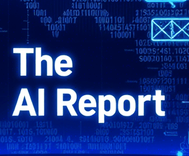Rachel James, AbbVie: Harnessing AI for Corporate Cybersecurity

The AI Report
Daily AI, ML, LLM and agents news
Navigating the AI Arms Race in Corporate Cybersecurity: Insights from AbbVie's Rachel James
The landscape of corporate cybersecurity is in constant flux, now propelled into a fresh 'arms race' where Artificial Intelligence stands as both a powerful shield for defenders and a potent new weapon for malicious actors. Navigating this increasingly complex battleground demands a deep understanding of not only the technology but also the evolving tactics of those who seek to exploit vulnerabilities.
To gain a frontline perspective, we connected with Rachel James, Principal AI ML Threat Intelligence Engineer at global biopharmaceutical giant AbbVie. Her insights reveal how leading organizations are harnessing AI to fortify their defenses and stay ahead of the curve.
AI-Powered Defenses: Real-World Applications
At AbbVie, James and her team are leveraging large language models (LLMs) to revolutionize their approach to security. This isn't just about relying on vendor-provided AI; it's about actively deploying LLM analysis on their own security detections, observations, correlations, and associated rules. The practical benefits are clear and immediate:
- Enhanced Alert Analysis: LLMs are employed to sift through a colossal volume of security alerts, intelligently identifying patterns, detecting duplicates, and performing critical gap analysis to uncover weaknesses before attackers can exploit them.
- Unified Threat Picture: A specialized threat intelligence platform like OpenCTI is central to their operation, helping to consolidate disparate digital noise into a coherent, actionable view of threats.
- Structured Intelligence: AI acts as the engine, transforming vast quantities of jumbled, unstructured text into a standardized format like STIX. This structured data is crucial for comprehensive analysis and integration.
The ambitious vision extends further: to use these language models to seamlessly connect core threat intelligence with every other facet of their security operations, from vulnerability management to third-party risk assessment. This holistic approach ensures that intelligence gained in one area immediately benefits the entire security posture.
The Double-Edged Sword: Essential Considerations for AI Adoption
While the power of AI in defense is undeniable, its adoption comes with inherent trade-offs and risks that business leaders must confront head-on. As a key contributor to the 'OWASP Top 10 for GenAI' initiative, James is acutely aware of the potential pitfalls:
- Embracing Generative AI's Unpredictability: The creative, yet often unpredictable, nature of generative AI necessitates an acceptance of inherent risks. Organizations must weigh the benefits against the potential for unexpected outcomes.
- Navigating the Transparency Gap: As AI models become increasingly complex, the transparency of how they arrive at their conclusions diminishes. Addressing this 'black box' problem is crucial for trust and accountability.
- Realistic ROI Assessment: The hype surrounding AI can easily lead to overestimating benefits and underestimating the effort required. A rigorous and realistic evaluation of the return on investment for AI projects is paramount in this fast-moving field.
Knowing Your Adversary: The Key to Proactive Defense
To build a robust cybersecurity posture, understanding your attacker's capabilities and intentions is as critical as understanding your own defenses. Rachel James's expertise lies precisely here, with a deep background in cyber threat intelligence and extensive research into threat actors' interest, use, and development of AI.
Her proactive approach includes:
- Adversary Tracking: Actively monitoring adversary chatter and tool development through open-source channels and automated collections from the dark web.
- Practical Vulnerability Research: As the lead for the Prompt Injection entry for OWASP and a co-author of the 'Guide to Red Teaming GenAI', James actively develops adversarial input techniques herself, staying intimately familiar with attacker methodologies.
This hands-on understanding of offensive techniques provides invaluable insights for strengthening defensive strategies.
The Future is AI-Driven: Embrace the Transformation
For James, the path forward is clear. She highlights a powerful synergy: the cyber threat intelligence lifecycle is remarkably similar to the data science lifecycle fundamental to AI/ML systems. This alignment presents an immense opportunity.
"Without a doubt, in terms of the datasets we can operate with, defenders have a unique chance to capitalise on the power of intelligence data sharing and AI," James asserts. The ability to process, correlate, and act upon vast amounts of shared threat intelligence, amplified by AI, offers an unprecedented advantage.
Her final message is both a rallying cry and a warning for cybersecurity professionals: "Data science and AI will be a part of every cybersecurity professional’s life moving forward, embrace it." The future of cybersecurity isn't just about using AI; it's about integrating AI and data science thinking into the very fabric of defense.
The message is unequivocal: adapt, learn, and leverage these powerful tools, or risk being outmaneuvered in this evolving digital arms race.

The AI Report
Author bio: Daily AI, ML, LLM and agents news
